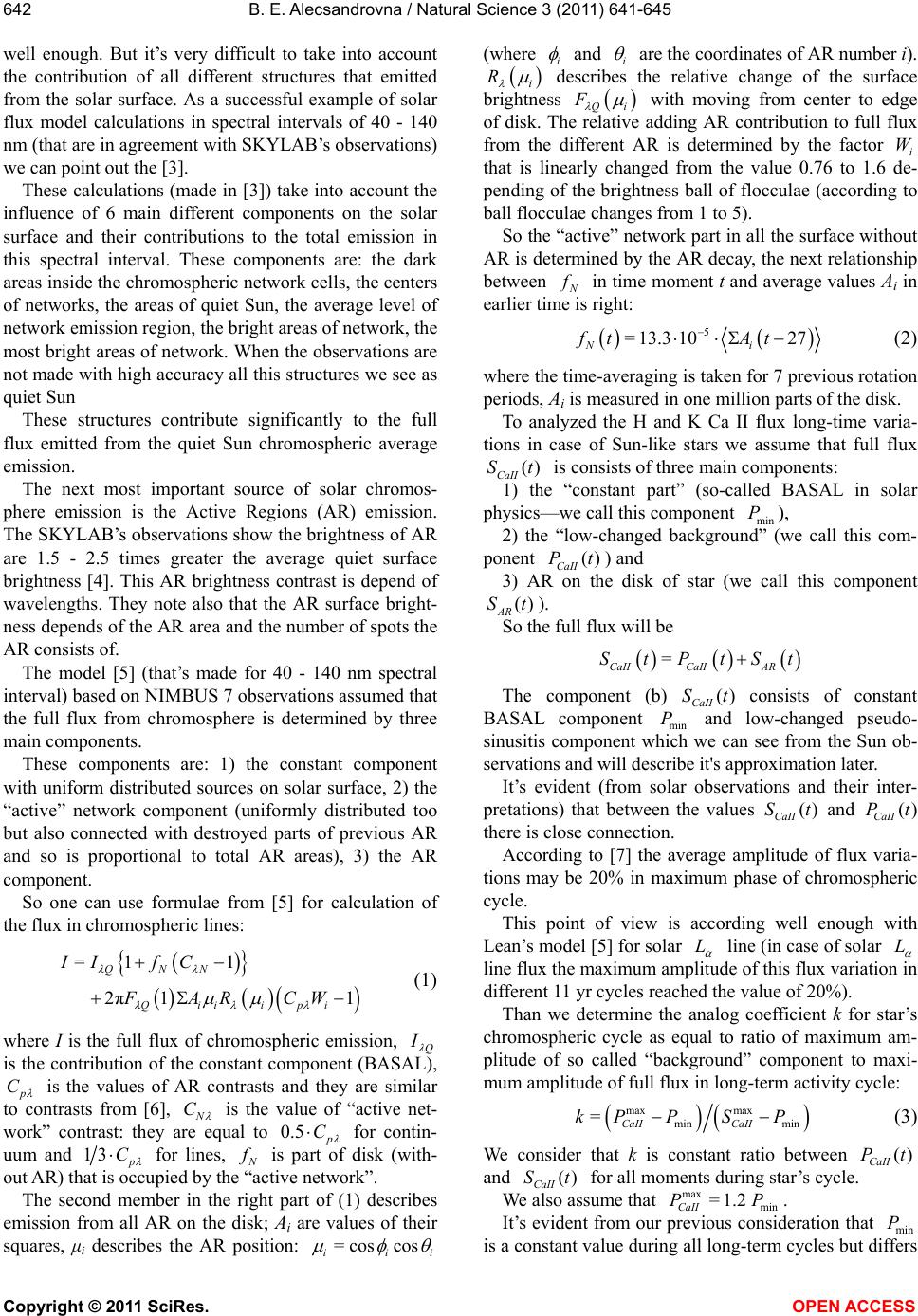
B. E. Alecsandrovna / Natural Science 3 (2011) 641-645
Copyright © 2011 SciRes. OPEN ACCESS
642
well enough. But it’s very difficult to take into account
the contribution of all different structures that emitted
from the solar surface. As a successful example of solar
flux model calculations in spectral intervals of 40 - 140
nm (that are in agreement with SKYLAB’s observations)
we can point out the [3].
These calculations (made in [3]) take into account the
influence of 6 main different components on the solar
surface and their contributions to the total emission in
this spectral interval. These components are: the dark
areas inside the chromospheric network cells, the centers
of networks, the areas of quiet Sun, the average level of
network emission region, the bright areas of network, the
most bright areas of network. When the observations are
not made with high accuracy all this structures we see as
quiet Sun
These structures contribute significantly to the full
flux emitted from the quiet Sun chromospheric average
emission.
The next most important source of solar chromos-
phere emission is the Active Regions (AR) emission.
The SKYLAB’s observations show the brightness of AR
are 1.5 - 2.5 times greater the average quiet surface
brightness [4]. This AR brightness contrast is depend of
wavelengths. They note also that the AR surface bright-
ness depends of the AR area and the number of spots the
AR consists of.
The model [5] (that’s made for 40 - 140 nm spectral
interval) based on NIMBUS 7 observations assumed that
the full flux from chromosphere is determined by three
main components.
These components are: 1) the constant component
with uniform distributed sources on solar surface, 2) the
“active” network component (uniformly distributed too
but also connected with destroyed parts of previous AR
and so is proportional to total AR areas), 3) the AR
component.
So one can use formulae from [5] for calculation of
the flux in chromospheric lines:
=1 1
2π11
QNN
Qiiipi
II fC
FARCW
(1)
where I is the full flux of chromospheric emission, Q
I
is the contribution of the constant component (BASAL),
C
is the values of AR contrasts and they are similar
to contrasts from [6],
C
is the value of “active net-
work” contrast: they are equal to 0. 5
C
for contin-
uum and 13
C
for lines,
is part of disk (with-
out AR) that is occupied by the “active network”.
The second member in the right part of (1) describes
emission from all AR on the disk; Ai are values of their
squares, μi describes the AR position: =cos cos
iii
(where i
and i
are the coordinates of AR number i).
i
R
describes the relative change of the surface
brightness
Qi
F
with moving from center to edge
of disk. The relative adding AR contribution to full flux
from the different AR is determined by the factor i
W
that is linearly changed from the value 0.76 to 1.6 de-
pending of the brightness ball of flocculae (according to
ball flocculae changes from 1 to 5).
So the “active” network part in all the surface without
AR is determined by the AR decay, the next relationship
between
in time moment t and average values Ai in
earlier time is right:
5
= 13.31027
Ni
ft At
(2)
where the time-averaging is taken for 7 previous rotation
periods, Ai is measured in one million parts of the disk.
To analyzed the H and K Ca II flux long-time varia-
tions in case of Sun-like stars we assume that full flux
()
CaII
St is consists of three main components:
1) the “constant part” (so-called BASAL in solar
physics—we call this component min
P),
2) the “low-changed background” (we call this com-
ponent ()
CaII
Pt) and
3) AR on the disk of star (we call this component
()
AR
St).
So the full flux will be
=
CaIICaII AR
StPtSt
The component (b) ()
CaII
St consists of constant
BASAL component min
P and low-changed pseudo-
sinusitis component which we can see from the Sun ob-
servations and will describe it's approximation later.
It’s evident (from solar observations and their inter-
pretations) that between the values ()
CaII
St and ()
CaII
Pt
there is close connection.
According to [7] the average amplitude of flux varia-
tions may be 20% in maximum phase of chromospheric
cycle.
This point of view is according well enough with
Lean’s model [5] for solar L
line (in case of solar L
line flux the maximum amplitude of this flux variation in
different 11 yr cycles reached the value of 20%).
Than we determine the analog coefficient k for star’s
chromospheric cycle as equal to ratio of maximum am-
plitude of so called “background” component to maxi-
mum amplitude of full flux in long-term activity cycle:
max max
min min
=CaII CaII
kP PSP
(3)
We consider that k is constant ratio between ()
CaII
Pt
and ()
CaII
St for all moments during star’s cycle.
We also assume that max
min
=1.2
CaII
PP
.
It’s evident from our previous consideration that min
P
is a constant value during all long-term cycles but differs